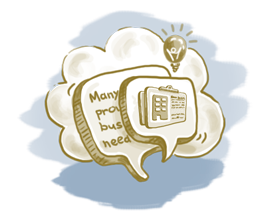Let’s face it: the twenty-first century business environment is web-centric. If your enterprise isn’t operating on the web, it is certainly depending on the web for important aspects of business operations. Of course these aspects include email, online ordering, lead generation and prospecting. But in the course of a sales cycle, they could also include other data available through the web, such as company information, statistics, map locations, or even business or industry news. It would be very handy to have this kind of data available right within a CRM software.
 General Data
General Data
A notable example of the assistance web services could bring would be, of course, maps. A meeting is scheduled at a particular location, and web data about that location can be displayed right in CRM, within the customer or prospect record and at the step of the sales process to which it applies. A sales rep can simply access CRM tool, and as part of meeting preparations have this data instantly available, instead of having to search for it. That data would be in context with the rest of the data needed for the meeting.
It can also be quite advantageous to have the latest industry news for a prospect or customer displayed right in CRM. It could provide a relevant talking point when making a sales call—and could even affect the sale itself.
In some areas and in some seasons, it might be advantageous to have updated weather information available, too.
There are endless ways web services could be used to achieve what should be the overall goal of a CRM software solution: sales velocity.
Company-Specific Data
Larger companies often have intranets that are only accessible to employees. On these intranets can be found important data such as inventory. If a salesperson is in the field at a customer location, and the sale might be made or broken on the availability of a particular product, the display of this data right in CRM could be vital. In today’s world, such information plays an important role within pipeline management.
Or in another example, a salesperson might need to know a customer’s credit standing with his or her company, because the customer is asking for special terms as part of a new sale.
If certain data isn’t normally available through the web but would be useful to salespeople through a CRM solution’s web services, a web application could be easily created by the company so that the data would be available in CRM to the sales force.
Mashup Framework
Web services for a CRM software are provided through a mashup framework—meaning the information is only displayed; it cannot be manipulated and sent back to the originating web site. Bi-directional functionality can only be accomplished if there are interfaces (known as APIs) both with the receiver and the sender that allow a two-way flow of data.
For most companies, this will be more of a benefit than a hindrance; data provided through web services is normally secure and manipulation of it from outside is not possible.
Today’s CRM Software Solution
Web services is yet another CRM software solution feature that makes it possible for a business to operate seamlessly within the web environment, and to utilize the web to its full potential in the advancement and execution of a sale through the sales process.
Along with the capacity to view email and social media posts in instant context within the CRM application, and the availability of auto-calculating fields, web services are an added attribute to a CRM software that truly and positively impacts sales velocity.
Web Services is only one of the breakthrough features of Pipeliner 6.0, coming in a few short weeks. Subscribe to our RSS feed and never miss a single news about Pipeliner CRM.





















